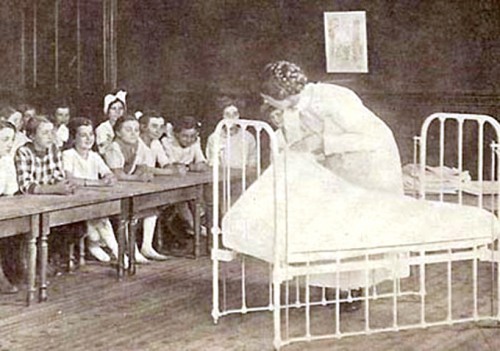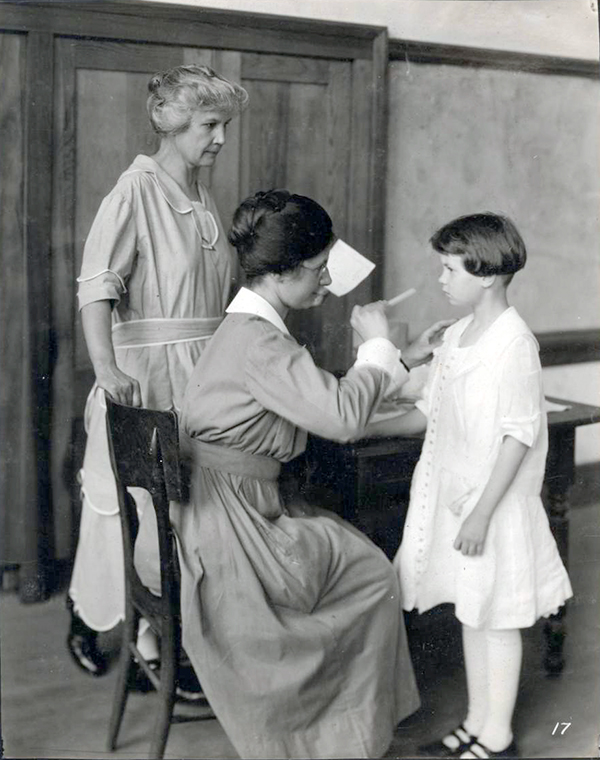School Nurses – Reinventing the Weel
I remember when my elementary school had a school nurse that we could go to for “boo-boo’s” and other things like shots. She was the one who called our parents to see what was wrong if we weren’t at school and checked our eyes each year to make sure we could see the blackboard.
Lina Rogers, very first school nurse
Gradually, without even any of us knowing they were doing it, the nurse began commuting between schools then not showing up altogether. What happened? Who’s doing her job?
And that was back when we didn’t even have a clue about epipens, insulin pumps, dietary prohibitions, mainstreaming or ADHD. These days it’s easier to find a cop on the school grounds than a nurse!
So who’s handling all of the hoofraw that goes along with these in-school medical issues? Well, as it turns out, the already-overloaded, can’t-touch-the-kids, can’t-discipline-the-kids, teach-without-books teachers are!
School Nurses: A Novel Approach
This very month, October, in 1902 an intrepid registered nurse, Lina Rogers RN, climbed the school-ground steps to begin an entirely novel 30-day experiment to see if she might be able to make a difference by helping out students with their medical and hygiene problems.
In 1897 New York City had hired 150 part-time physicians to spend 1 hour per day inspecting students for contagious diseases like lice, impetigo and tuberculosis. They only had authority to send a child home with a note excluding them from school.
The approach backfired and left thousands of children wandering the streets and tenements instead of attending school each day. That troubled a humanitarian caring for the poor of the Lower East Side, Lillian Wald, who had recently moved her charitable activities into a donated building on Henry Street. It was she who had recruited Mrs. Rogers for the task.
Lina tended to the health of 10,000 students in four schools – and made a difference from her very first day. By 30 days the rate of absenteeism had decreased drastically, non-contagious students were being helped at school and students with vision and hearing disabilities had been identified. To their credit the bureaucrats saw value and continued the program, even expanded it.
Dressings were changed (rat bites), contagious students dismissed with follow-up education on hygiene and prevention, the community assisted children without food or clothing and nurses sought out older children staying home caring for younger children while parents worked.
Within six months, absenteeism fell by 90 percent, and the school board agreed to supply funds for 27 nurses. By 1914, there were close to 400 nurses in the schools of New York City. Other towns followed quickly; Los Angeles hired its first in 1904.
School Nurses: Not a Novel Approach
So, here we are 113 years later, October 2015, and we’ve got to convince the bureaucrats all over again that health care in the schools is worth spending our already-given tax money on.
As part of a study about the finances of having a school nurse, researchers in Massachusetts compiled some statistics about school nurses in the nation. Less than half of the nation’s schools have direct access to a nurse. Most who do, have them part-time and many only in a consulting manner.
Anne Sheetz, Director of School Health Services at the Massachusetts Department of Public Health, revealed that school nurses see at least 60 to 70 kids each day and provide emergency care, mental health services and chronic care management in addition to teaching others about issues such as life-threatening food allergies.
“I could not believe the amount of health care that was being done in schools and the critical nature of it,” she observed; so, before retiring, she did a pilot study to calculate all of the various financial cost-benefits of going “old school” and placing a full time nurse in a school.
Study Results
To assess the Massachusetts program, the researchers compared money spent putting full-time nurses in schools with money the program saved by reducing doctors’ visits and keeping parents at work and teachers in front of the classroom.
For the 22 types of procedures school nurses performed during the study, from testing blood sugar to administering physical therapy, the researchers calculated how much it would cost to go to a clinic or hospital for the same care.
To measure lost wages for parents, they determined the time parents would have to take off work if children were dismissed early, as well as how often they would have to come to school to help kids take their prescription medications if no nurse was on site.
Finally, to assess teacher productivity, they referred to an earlier study that found every teacher in a school spent 20 fewer minutes every day dealing with student health issues once a nurse was assigned to their school.
Massachusetts records showed that during the 2009-2010 school year, about 477,000 students at 933 schools covered by the program received school health services. Paying nurses to provide those services cost $79 million.
The same care provided outside of school would have cost $20 million. In addition, with no school nurses parent productivity losses would have totaled $28.1 million and teacher productivity losses, $129.1 million.
The researchers calculated that every dollar invested in the school nurse program saved $2.20 overall and they published their work in the May 19 issue of JAMA Pediatrics. The Full article is available here.
“Funny money”
It seems ridiculous and disgusts me that these trained researchers need to waste their time to quantify in print something that is so in-your-face-obvious anyone with common sense can see plainly: School nurses are not only productive and cost effective but essential.
The greatest issue is that the costs and the benefits aren’t matched. Those reaping the most direct financial benefit – parents not missing work, employers not missing employees, insurance companies not paying excessive bills, etc – aren’t the ones expected to pay the cost, the school system does.
Well, parents do pay for school programs by giving their money to bureaucrats; but, really they have no say over whether school nurses are hired or a multi-million dollar computerized marquee is purchased for the front of the building or 20 acres of ready-grown sod is bought to avoid having to plant grass.
How is your school doing?
Do the schools your children attend have a school nurse?
If so: Remember them this month (October) with a short note.
If not: Start by asking the principal – Why not?
[JAMA Pediatr 2014]



